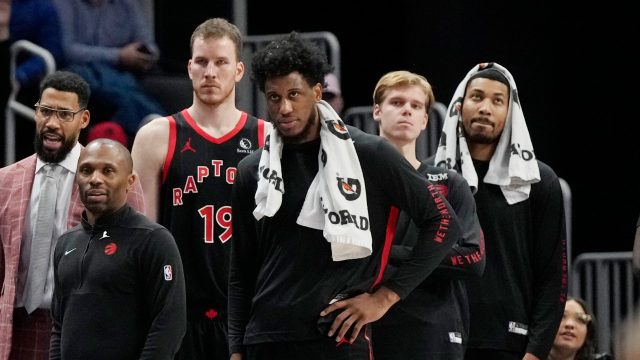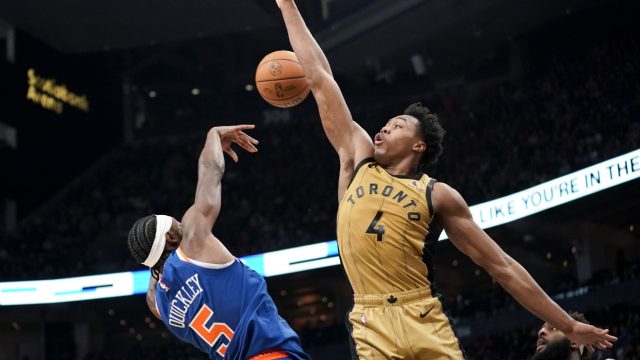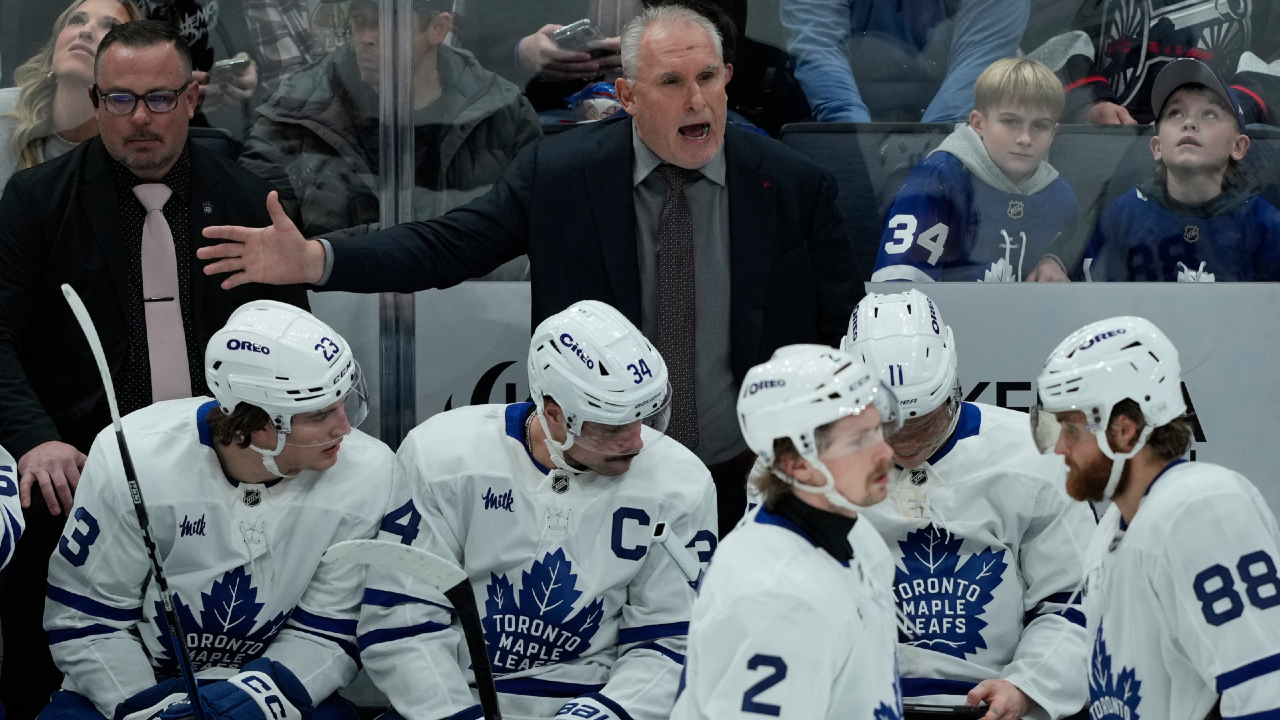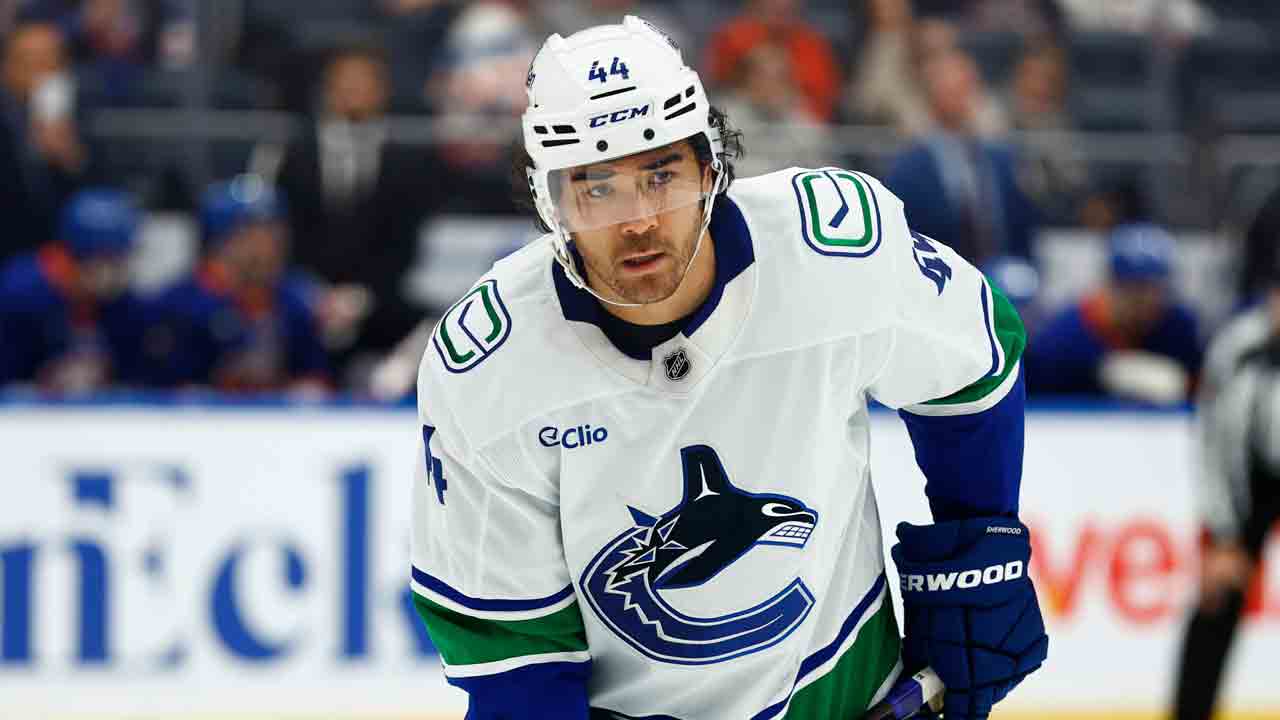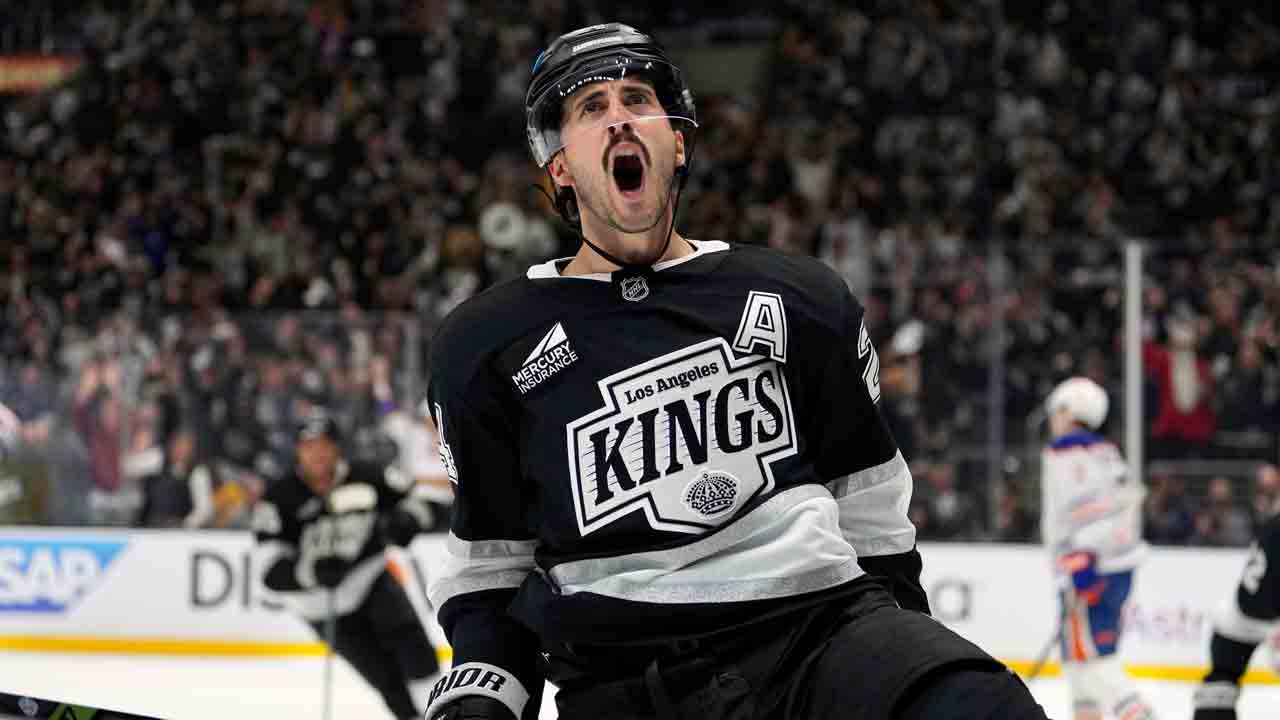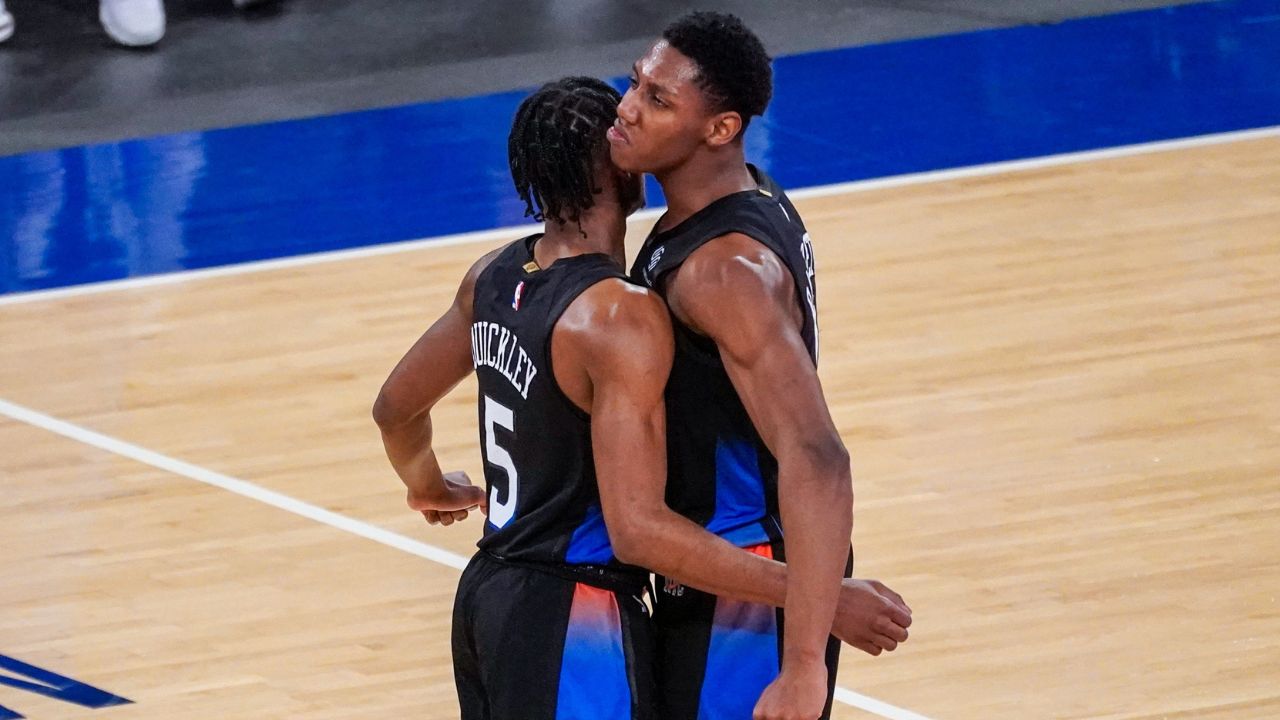
It happened a little sooner than anyone anticipated. Rather than wait until the Feb. 8 trade deadline to canvas the league for a better offer a while longer, the Toronto Raptors traded OG Anunoby to the New York Knicks on Saturday.
I got most of my feelings out over the course of a two-hour emergency show, and with plenty of trickle-down still to analyze, I’ll be brief with my primary reaction: Losing Anunoby is hard, as he’s been an excellent Raptor and fills a very necessary role on a good team. However, his value is significantly higher to a team that is good now than one that wants to be good sometime in the near-ish future. Most readings of the tea leaves also suggested that it would require a very large contract to retain him as an unrestricted free agent this summer, and if he could get more money and a new (and winning) situation elsewhere, he’d go the Fred VanVleet route. It’s unfortunate the team is in a spot where players would like to see if other pastures are greener. If, however, you were resigned to Anunoby leaving in free agency, the return the Raptors got back from the Knicks is a strong one.
In acquiring Immanuel Quickley, R.J. Barrett, and Detroit’s second-round pick this year, the Raptors have accomplished three things with the Anunoby trade. They have added a high-upside guard who, if he develops as many think he can, should be an excellent complement to Scottie Barnes as they grow together. They have added a well-liked starting-calibre wing who, while already paid full value for this potential, might reach a new level in a fresh situation. And they restocked a fairly thin draft cupboard with what will be a pick in the 31-33 range this June.
How you feel about the deal probably hinges on a couple of to-be-determineds. (And maybe you’re still too steamed from Saturday’s loss anyway.) The next contracts Anunoby and Quickley receive will colour this deal some. How you feel about Quickley as the key asset versus the reported three picks the Raptors could have received a year ago is a matter of preference. (Keep in mind that “three picks” is vague; three unprotected firsts from bad teams are much different than three protected firsts from good teams. There are details missing from last year’s reporting.) And I think everyone has some degree of “what’s next?” as a footnote on their evaluation. We can’t answer those questions today.
What we can do is get to know the new pieces a little better. What follows is purely a look at the players involved. Tomorrow, we’ll dive deeper into how this reshapes the cap picture and what subsequent moves may or may not be necessary.
Immanuel Quickley
One of the toughest parts of being a “seller” in trades is deciding what you’d actually like back. For some teams whose competitive window is far in the future, with unlimited patience, that’s easy: Take whatever the best asset is. Not every team is open to years in the lottery wilderness, though. A team like the Raptors, who have shown no appetite for a longer rebuild, have to weigh the value and upside of picks against the chance to get young players who are ready to play now.
In acquiring Quickley as the key piece in an Anunoby return, the Raptors clearly preferred the latter. That’s probably the right call. Barnes is ready to win now, in his third year, and while the economics of NBA rookie-scale extensions mean a top prospect is almost always going to sign that max extension – Barnes can sign one this summer – the clock begins ticking on winning around that player as soon as pen is to paper. The Raptors targeted two players who were playing real roles on a winning team right now, and who are within 26 months of Barnes’s age. The trade fits the idea that “Hey, selling might be a tough step back, but we intend to be good again soon.”
Once you’ve decided to prioritize NBA talent over picks, the challenge becomes finding someone you can trade for who could become an even better player down the line. The Raptors famously bet a lottery pick that Kyle Lowry could become a much better version of himself in the right situation. More recently, the Thunder and Pacers identified Shai Gilgeous-Alexander and Tyrese Haliburton, respectively, as late lottery picks coming off good but not elite rookie seasons who could reach another level. In trying to identify who the next one of those could be a few weeks ago, Quickley made my list.
There is a lot to like here. The No. 25 pick in 2020, Quickley has been a rotation-calibre player since day one with the Knicks. His role grew for a time, but the acquisition of Jalen Brunson meant he was blocked to a degree in New York, rendered a very good backup since Tom Thibodeau was unwilling to play big minutes with two smaller guards on the floor together. “Blocked by a possible All-NBA guy” is not really a knock on Quickley, who has found ways to become a better version of himself within that narrower role.
The most notable skill with Quickley, both for his fit with Barnes and projecting him to a larger role, is his shooting. He’s hit 39.5 percent of his threes this year and 37.7 percent on over 600 attempts since the start of 2022-23. Those are good numbers on their own, and there’s more under the hood suggesting he’s a very, very good shooter. Not all attempts are created equal, and Quickley takes a lot of self-created pull-up threes above the break, a much tougher shot than a catch-and-shoot corner look, for example. He’s hit a whopping 40.6 percent of those pull-ups, one of the best marks in the entire NBA. That is a very important skill in terms of how defences react to you and what you can accomplish in pick-and-roll scenarios, and because he’s such a good shooter with a difficult diet of shots, we can more safely conclude he’ll continue to be a good shooter, especially if he gets more off-ball looks when Barnes initiates.
And Barnes should still initiate plenty. Acquiring Quickley, nominally a point guard, doesn’t mean Barnes won’t be operating as a lead guard for significant stretches. Quickley is a very good pick-and-roll operator and a fun, willing passer, but to this point, he’s profiled more like a combo-guard than a pure point. He’s a scorer first, and a playmaker second. That could very well change in Toronto, where the offence is structured much differently than in New York, with far less isolation play and a greater emphasis on second-side playmaking; Quickley should be able to expand the point guard parts of his profile pretty smoothly.
Still, Quickley’s New York profile looks like one that fits very well with Barnes – handle some of the duties bringing the ball up the court, initiate some pick-and-roll sets, but also be able to thrive moving into more of a two-guard role when Barnes is the primary, working as an off-ball movement shooter and cutter. That versatility is really important, and how Barnes and Quickley develop chemistry will probably be the most fun part of the next three months. The same goes for Quickley and Pascal Siakam, if Siakam sticks around. Teams are just not going to want to switch any actions with Quickley handling and Barnes or Siakam screening, and there are tough tradeoffs for a no-switch defence with offensive players of that calibre.
There are other areas Quickley can look to improve. While he’s a very good shooter, from long-range and in the mid-range, he has not done particularly well getting to the rim in his career. He is turning how defences respond to him into space to let an elbow jumper go rather than using the can’t-go-under coverage to turn the corner and drive. That’s fine, but you’ll want to see him get deeper into the paint a little more often, especially because he’s an excellent finisher in the floater range and has been a solid finisher at the rim prior to this year. His numbers as a driver suggest he should do more of it, even if it means we get a few less of those sweet-looking, slithering mid-range attempts. (He also makes Jakob Poeltl’s fit in the starting lineup much more appealing offensively, as Poeltl should feast on dump-offs, if not traditional feeds to him as a roll-man.)
Defensively, Quickley isn’t the standard point-of-attack hound the Raptors have traditionally preferred from their point guard. He is fine in those situations, but more of his defensive value comes from his work off the ball as a disruptor or reacting to help or scramble situations. He’ll need to improve one-on-one and in pick-and-roll because the Raptors don’t figure to start anyone else you’d want guarding opposing initiators for long stretches of time, and translate some of that off-ball verve into initial deterrence. The Knicks were consistently better on defence with Quickley in the game. He’s also an excellent defensive rebounder for his size and should fit the Raptors’ ethos of grab-and-push to fuel the transition game.
All told, I love the Quickley gamble. When I identified him as someone the Raptors should target a few weeks back, I was skeptical it could happen because of the ongoing Knicks lawsuit. I’m glad that didn’t get in the way of actual basketball business. Based on the offensive profile and his multi-year on-off impact with a quality Knicks team, Quickley is pretty clearly ready for a starting role in the NBA. There are a lot of indicators that he could evolve into a co-starring role, too, if he can sharpen some of the more average parts of his game.
R.J. Barrett
Barrett, meanwhile, feels like more of a known commodity. Hyped early as potentially the next great Canadian player, Barrett was selected third overall, eventually signed to a monster extension, and has worn the weight of those expectations since. The results have been mixed. At worst, Barrett is a starting-level wing; In his best season, 2021-22, he looked like maybe he could be the third-best player on a very good team, averaging 20 points with a bump in assist rate and a remarkably low turnover rate. At other times he’s looked like a fringe-y starter because the offensive game – and especially the outside shooting – have been so inconsistent.
A lot of the discussion around Barrett will centre on two philosophicals. First, can a fresh start – one with pressure as a hometown kid, but a different kind of pressure than New York, with more runway to develop before team-level expectations set in – help Barrett get back on the trajectory he appeared to be on in his third season? And second, does the fact that he’s still 23 suggest more upside to come, or is five years of being mostly the same guy over 10,000 minutes tell us he is who he is? Reasonable people can disagree on either point.
There are basketball reasons to think Barrett might be better off in Toronto, though. New York runs a pretty stagnant offence, one that’s very effective but doesn’t allow a lot of opportunity for secondary playmaking or more complementary actions. Barrett has found a role within that as an excellent cutter and someone you can throw the ball to late in the clock to create a shot, but he’s never found an efficient role in New York’s offence like that.
We’ve seen Barrett, both with the Knicks in the past and with Team Canada, thrive in more flowing situations, leveraging his transition play and his ability to read scrambled defences. He can play with great pace when he wants to, and if Toronto can do a better job creating initial advantages on one side of the floor, Barrett is really strong attacking against closeouts. In other words, he is not great at creating his own advantages, but he can really deliver on initial advantages created for him by others. The Raptors’ new offence hasn’t produced great results yet, but that’s kind of the idea they’re going for; Barrett is a theoretical skill-set fit for Darko Rajakovic’s vision, we just need to see results beyond the theoretical.
Barrett also has to be a better shooter, full stop. He’s at 34.2 percent on threes for his career and 32.7 percent over the last three seasons. Almost none of his looks are self-created, either, so while an improved free-throw percentage is mildly encouraging for his shooting growth, he doesn’t have the same promise of easier shots or scaling up that Quickley does. He also has to finish better at the rim, a place he gets to well yet has been in the bottom quarter of the league, among wings, in field-goal percentage at the cup.
It’s on the defensive end where Barrett more clearly has room to keep growing. He’s solid, and has at times flashed a higher ceiling than that despite generating very few turnovers and being just an average rebounder. The Knicks probably overextended him as their lockdown guy in a starting unit with a few shaky defenders. Barrett has good size and excellent strength, so the tools are there. The Raptors will challenge him to be better on that end, both for his long-term outlook in the league and because there’s an Anunoby-sized hole to fill on the defensive end of the floor now.
Barrett is a less obvious fit, on-court and long-term, than Quickley. The hope will be that he can improve his defence and shooting, and that he can become more efficient as a scorer, likely with less usage. (I’d be shocked if he gets to attack one-on-one and drive as much as he did in New York, even if the Raptors could use the free throws he generates.) More of my Barrett thoughts lie in how his contract fits with the bigger picture in Toronto, which we’ll look at tomorrow. Purely as a player, it’s a part of the trade that was necessary to land Quickley and a reasonable enough bet that, in a rising cap environment and at age 23, they can get at least fair value out of Barrett’s pretty sizable salary the next few years.
The second-round pick
The Raptors don’t control their 2024 first-round pick and didn’t have a second-round pick in 2024 or 2025. They have been operating at a pick deficit for years, in equal parts because they used picks for win-now trades during the title season and because they used them in cap- and tax-saving salary dumps. The result of having fewer kicks at the draft can are obvious in the team’s lack of roster depth and player development success over the last few years. A pick in the early 30s isn’t likely to provide a major contributor but look around the league and second-round picks are contributing plenty, usually at immense value over their salary.
OG Anunoby, Precious Achiuwa, and Malachi Flynn
The cost here is obviously significant. Anunoby is a remarkably good fit in New York, even if they similarly feel the cost was significant. On a purely asset basis, including Flynn and taking on Barrett’s deal probably should have been enough; Achiuwa’s inclusion, with the Knicks down Mitchell Robinson for the season and Jericho Sims shorter-term, probably got the deal over the finish line.
In dealing Flynn and Achiuwa, both restricted free agents this summer, the Raptors waved the white flag on turning them into long-term rotation pieces. Both got ample opportunity. Achiuwa is still a rotation player in the league. Flynn probably sticks on as a third point guard for a while. Even if one of them pops up as a redraft candidate in their next stop, I don’t think the Raptors will feel too badly about the chances they were given (at least this year for Flynn).
What’s next
It’s currently expected that Quickley and Barrett will debut Monday, as long as all five players pass their physicals in time. Historically, teams will lean toward bringing new players off the bench for a game or two while they get up to speed, especially with no practice before Monday’s game.
Quickley should be starting as soon as he has his footing. The Raptors need to see how far he can expand his role, and he’s already better than the other alternatives in-house. Whether Barrett starts or comes off the bench is a more open question, as you would make a case for him (better overall, has been starting regularly, long-term contract) or Gary Trent Jr. (spacing, and has looked better of late) in the fifth spot. Maybe they mix it up game-to-game or week-to-week to get different looks.
As mentioned off the top, tomorrow we’ll look at all the cap ramifications of these moves, in a scenario where this is all they do and in alternate scenarios.



